Unlocking Andrew Wiggins' potential

PORTLAND, Ore. — When a budding star achieves success despite trying circumstances, he deserves heaping praise. More important than the trophies and recognition, though, is that his franchise fully commits to asking and answering a simple, crucial question: "How do we make life easier on our star?"
That's exactly where Andrew Wiggins and the Timberwolves find themselves with their season ending next week.
Indeed, a central plank in the Timberwolves' Rookie of the Year campaign for Wiggins has been the argument that no first-year player has been asked to do more than the 2014 No. 1 overall pick. There's plenty of supporting evidence to be found on the court and in the stat sheet. Wiggins has played 600+ more minutes than any of his teammates, he's plugged away even though Minnesota's roster has been shredded by injuries and trades, and he's managed to become one of the most prolific teenagers in NBA history despite receiving constant attention from opponents.
Wiggins' valiance is boosted by his consistent competitiveness in the face of the Timberwolves' horrific 16-62 season. The nature of his offensive game has been far more aggressive and effective than many observers expected it to be after spending just one season at Kansas.
"There's not a discussion for Rookie of the Year," Timberwolves coach Flip Saunders declared Wednesday, before Minnesota's eighth straight defeat, a 25-point loss to the Blazers in which Wiggins scored 29 points and logged 41 minutes on the second night of a back-to-back. "Every time he goes into the game, the other team's scouting report is to stop him. ... I don't think you can take any [other] rookie and put him on our team, and we would be as good as we are, and they would do as well as [Wiggins has] done. ... Based on what he's been able to do, the amount of minutes he's played, what the expectations have been of him, he's been an A+."
Nerlens Noel's progress giving 76ers something to feel good about
Saunders has been beating Wiggins' drum for weeks now, as counter-arguments in favor of Bulls forward Nikola Mirotic, Sixers center Nerlens Noel and Magic guard Elfrid Payton have emerged. Wiggins will almost certainly win the award, in large part because he is a very conventional candidate: he's the top overall pick, he's easily led his class in scoring (16.7 points per game) and minutes (35.9), he's yet to miss a game this season, and he plays an electric, above-the-rim style that produces plenty of highlight-reel fodder for casual voters who might not be subjecting themselves to 82 games worth of Timberwolves tape. Minnesota's public relations department has underscored that last point by sending out pairs of socks bearing Wiggins' likeness to voters, reminding them that he's "knocked their socks off" this season.
Two things stand out most about Wiggins' rookie campaign: the scale of his production at such a young age, and the degree to which he has already myth-busted many assumptions about his projected trajectory. Wiggins is on track to post the fifth-highest scoring average ever for a teenager, behind four perennial All-Stars in Carmelo Anthony, LeBron James, Kevin Durant and Kyrie Irving.
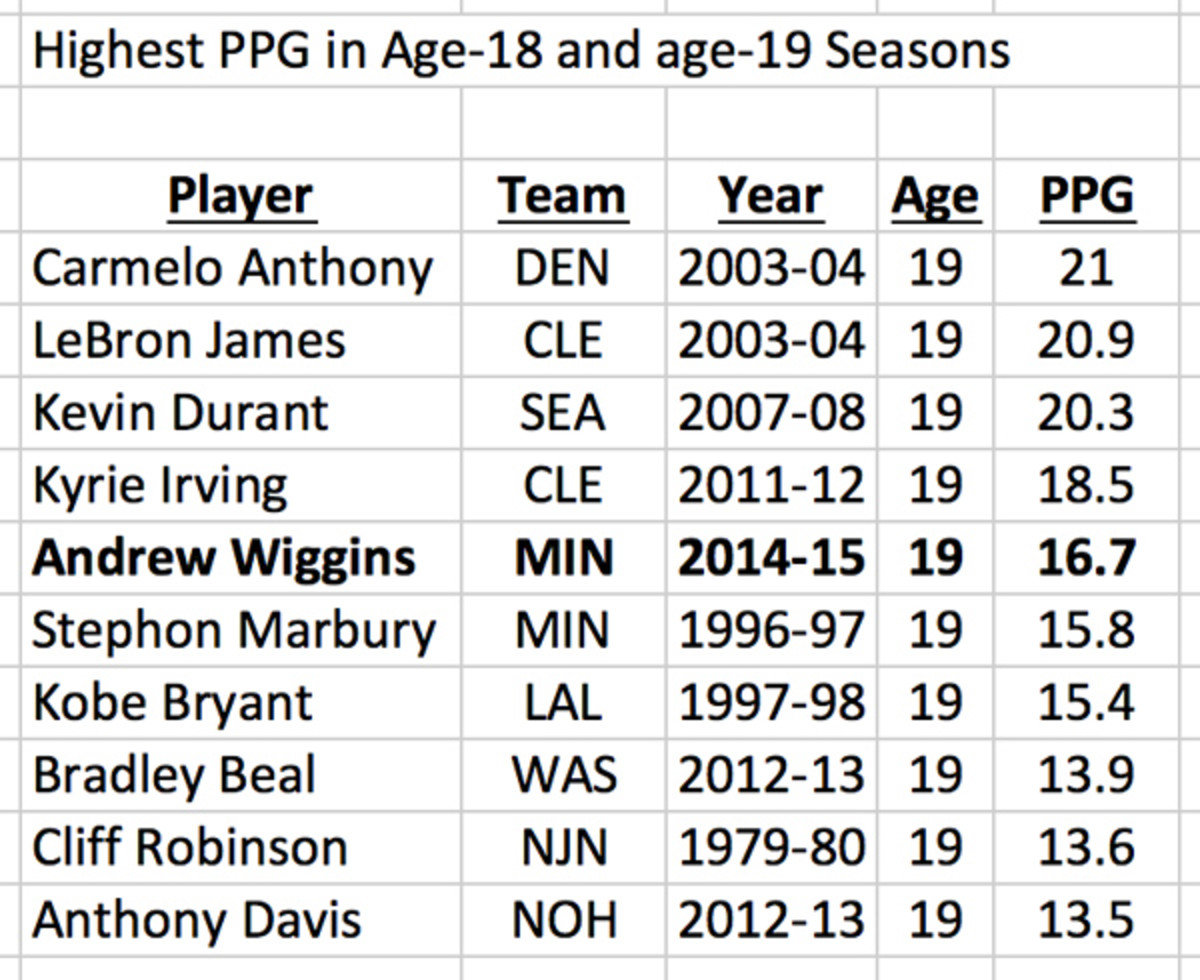
In pre-draft comparisons with No. 2 pick Jabari Parker, Wiggins was usually cast as the better athlete with a higher ceiling, while also being labeled less NBA-ready and less physical. Additionally, he faced questions about his strength, his ball-handling, his engagement on a play-to-play basis, and whether he was wired to take on an alpha scorer's load.
Many of those concerns now look completely overblown. Wiggins has figured out how to put his quickness, natural instincts and leaping ability to full use, particularly since the All-Star break. He looks increasingly comfortable attacking defenders from the perimeter, he's able to turn the corner more often than not, he's capable of establishing position and creating good looks from post-ups, he gets to the foul line regularly by generating contact, and he hasn't really had the option of "floating" for long stretches because Minnesota's other players are so limited.
• MORE NBA: Video: Wiggins posterizes Jazz center Rudy Gobert
Although Wiggins is only willing to give himself a "B" for his rookie season, pointing to his slow start and the need to improve his off-ball defensive habits, he suggested that he has done enough to win the award.
"I feel like it's a goal for every rookie. I want to be [Rookie of the Year]," he told SI.com. "I would definitely vote for myself. [I'm] just being confident in myself."
With Parker sidelined in the first half by a season-ending knee injury, Mirotic is Wiggins' chief Rookie of the Year competition. The two players stand in stark contrast when it comes to age, role, team circumstances and statistical production. Mirotic is 24, more than four years older than Wiggins, and is only a rookie by definition. Mirotic was drafted in the first round in 2011, but elected to play professionally overseas for three seasons before coming over. Rather than serving as a starting centerpiece for a lottery team—the traditional profile for a Rookie of the Year—Mirotic has been a key reserve for one of the East's top playoff teams, averaging 10 points and five rebounds in 20.1 minutes and taking on added responsibilities due to multiple late-season injuries.
Years spent playing for Spanish powerhouse Real Madrid have molded Mirotic into a confident, crafty and polished player who has leveraged a favorable team dynamic in Chicago into advanced statistics that blow away Wiggins across the board. Saunders may be right that Wiggins has been forced to carry the biggest burden, but Mirotic has unquestionably packed more production into his minutes, and he's compiled all of his numbers in meaningful games while facing playoff stakes.
Even if the NBA intelligentsia might not be ready quite yet, there may soon come a day when a player with Mirotic's clear advantage in the advanced numbers is viewed as a far more deserving candidate than a player with Wiggins' edge in the raw numbers.
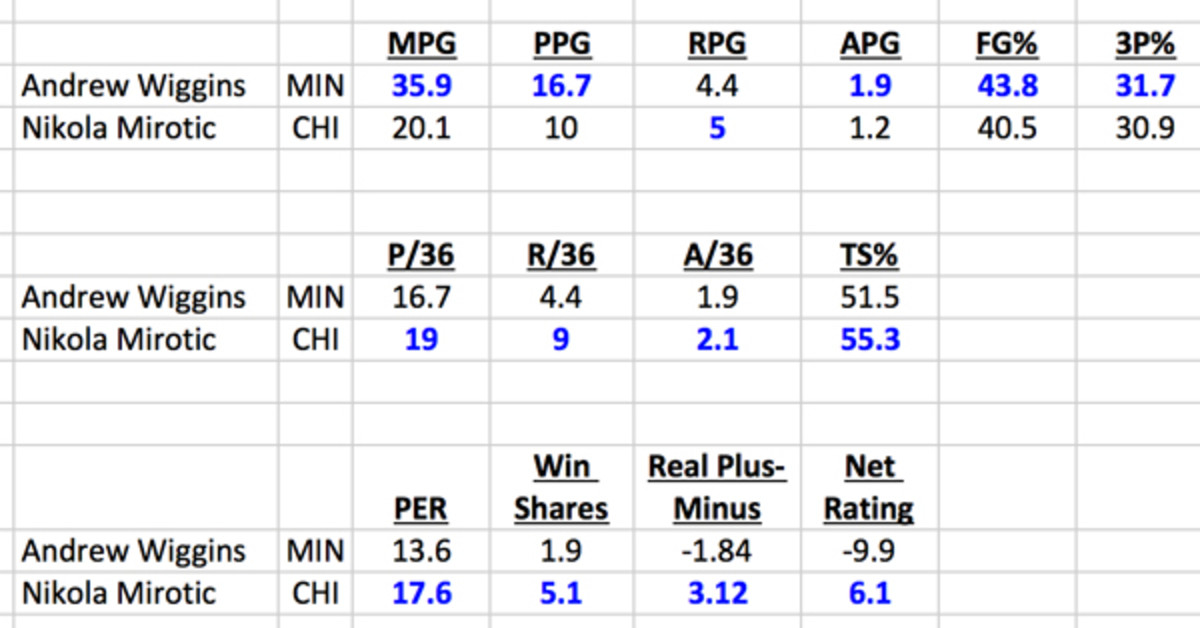
A good chunk of Wiggins' rough advanced numbers can be explained by Minnesota's self-imposed adversity. Saunders released J.J. Barea in October and traded away Thaddeus Young, Corey Brewer and Mo Williams in midseason deals, exacerbating existing depth issues while ushering in a youth movement. Despite a host of injuries, it has been Saunders' decision to lean on Wiggins heavily from a minutes standpoint. Saunders said Wednesday that he "isn't into" the idea of the strategically resting players and that it's "better for everybody" if players try to play all 82 games. At the same time, he acknowledged that the workload has caught up to Wiggins a bit in recent weeks. For context, only two players, James and Anthony, have logged more minutes than Wiggins in their age-19 seasons.
Wiggins feels the stress of these big-picture decisions on a play-by-play, night-to-night basis. That stress has been magnified by Saunders' general approach on offense and his short-term vision for Wiggins. This season, Minnesota has ranked dead last in three-point attempts, a standing that falls in line with Saunders' track record. In his 15 full seasons as a coach of the Timberwolves, Pistons and Wizards, Saunders' teams have taken an above-average number of three-pointers just once while ranking No. 25 or worse in three-point attempts nine times.
Matt Barnes: The Clippers' polarizing pariah who tells it like it really is
Meanwhile, Saunders has encouraged Wiggins to be assertive, in hopes of developing a scorer's mentality and making the most out of his top-shelf athleticism. As a result, Wiggins is averaging more than five free throw attempts per game, nearly half of his field goal attempts have come from inside 10 feet, and he's averaging just 1.5 three-point attempts per game.
"I think he can become a better three-point shooter," Saunders asserted Wednesday. "You don't want that to become a main part of his game. Anytime he shoots a three or a 20-foot shot, the guy who is guarding him goes, 'Woo, thank God.' When [Wiggins] starts coming at [the defender], doing his whirly-dervy, they're going to foul him or he's going to score. Something is going to happen."
As a method for easing Wiggins into the NBA, the idea sounds good and makes some short-term sense. After shooting 34.1% on 3.6 three-point attempts per game at Kansas, Wiggins is connecting on just 31.7% of his threes this year, and he's made just four three-pointers since the All-Star break. With Ricky Rubio sidelined, Minnesota lacks a true set-up guy to get Wiggins easy looks, and launching contested, off-the-dribble threes while playing 35+ minutes against starting wings is a good recipe for efficiency-killing possessions.
As a long-term approach, though, this "attack, don't settle" thinking amounts to a false dichotomy that, if continued, will serve to stunt Wiggins' usefulness in a league that increasingly relies on the three-pointer. A quick comparison of Wiggins to the other top teen scorers reveals that he lags far behind when it comes to three-point frequency. This is a gap worth closing.
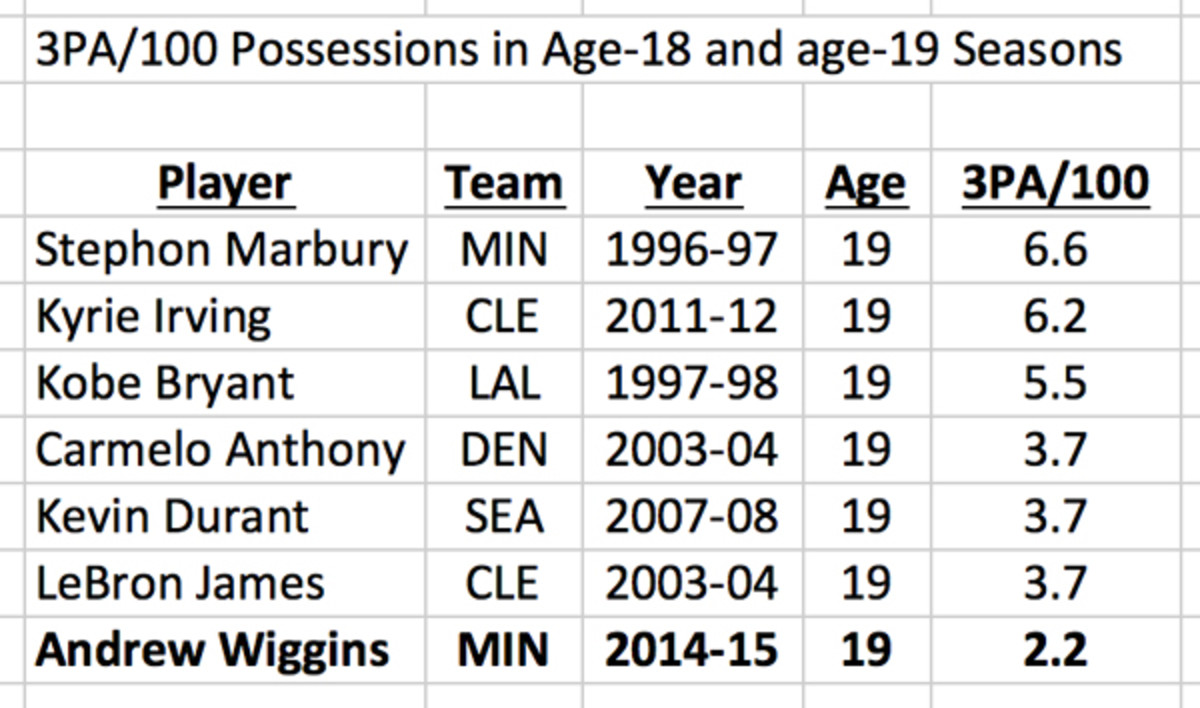
Wiggins is a player blessed with no talent limits and he absolutely possesses the highest ceiling in the 2014 class. There's really no getting around this: for Wiggins to reach his potential as an elite wing—to join the likes of James, Durant, Paul George, Kawhi Leonard, and others—he needs to hone a dependable three-point shot and he needs to have a green light from the coaching staff, sooner rather than later. The three-point shot must be "a main part" of Wiggins' game and a top priority in his development. He also needs to be surrounded by capable shooters who can help him make the most of his ability to collapse defenses and work out of the post.
Whom do defenders truly fear more: Durant, an all-around scorer who can beat you at the rim and from beyond the arc, or DeMarDeRozan, an eager attacker with little range? How did the Heat take LeBron's game to the next level? By maximizing the space around him and working to improve his own three-point shot.
The Floppies: The 10 most ridiculous dives of the 2014-15 NBA season
When elite wings pull up for three, defenders don't say, "Thank God." They groan, "Oh s---." Expecting Wiggins to become Durant might be asking too much. But allowing him to become DeRozan is asking too little.
The way Saunders laid it out, only good things can happen when Wiggins goes to the hoop. It's just not that simple. Against Portland, Wiggins played quite well, getting to the free-throw line 15 times and unleashing a flurry of quick spins that left multiple Blazers defenders grasping at air and hacking his arms. However, he shot just 9-for-22 from the field and took just one three—numbers that aren't exactly keeping assistant coaches awake at night.
Here's a sample of what Wiggins sees when he's going to the hoop. Possession after possession, he's staring down two, three and even four defenders, as the Blazers shamelessly cheat off of his teammates, gamble for strips on his drives, and contest his paint attempts with at least one body. Possession after possession, he's left with no choice but to force tough shots.
First, Wiggins shoots over a taller defender with five sets of eyes on him and four defenders tucked tightly into the paint.
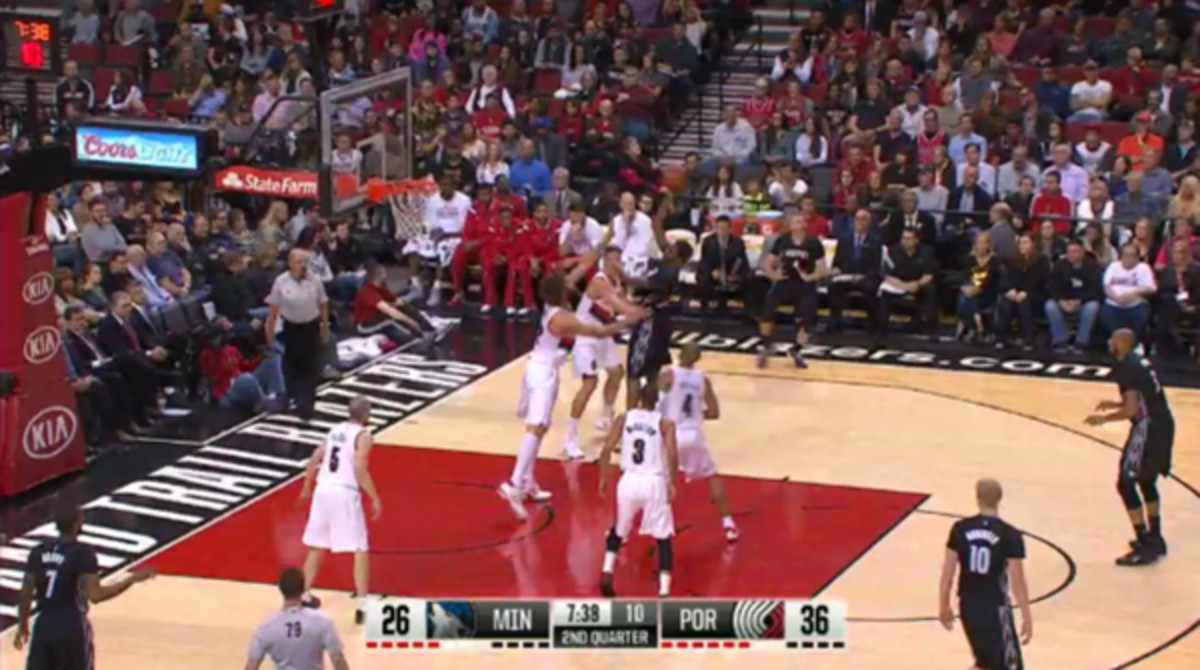
Second, Wiggins has to split two defenders just to enter the paint, where he encounters bodies in every direction and a taller defender directly between himself and the rim.
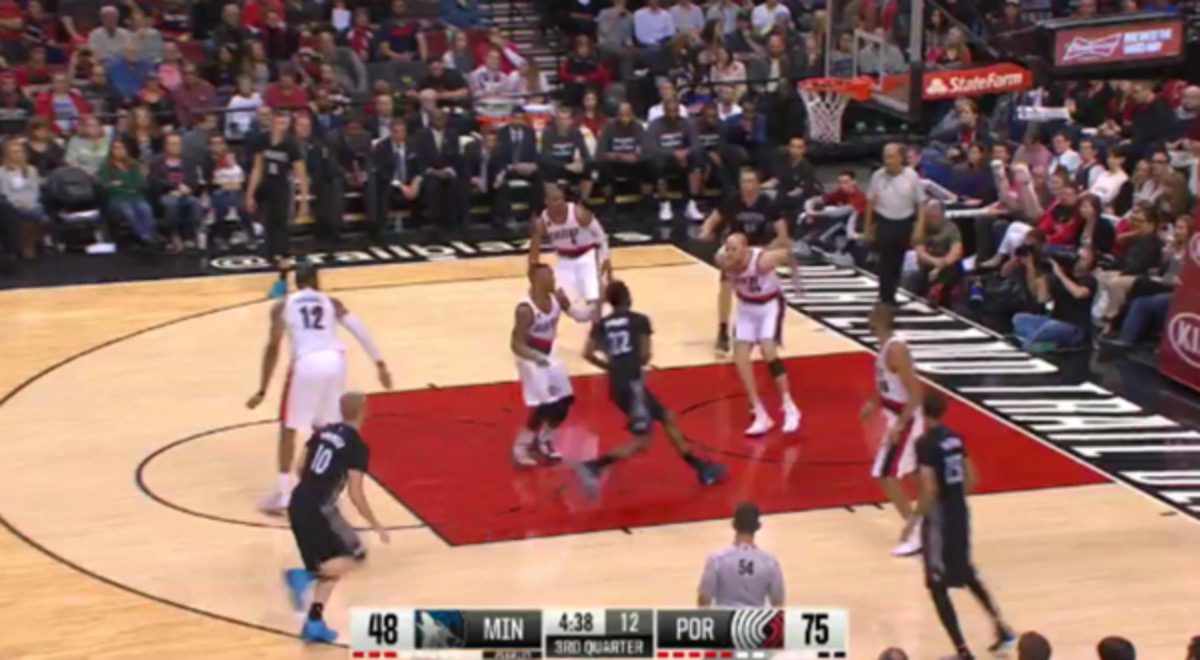
Third, Wiggins attacks off the dribble and sees two second-level defenders and two other weakside defenders waiting for him.
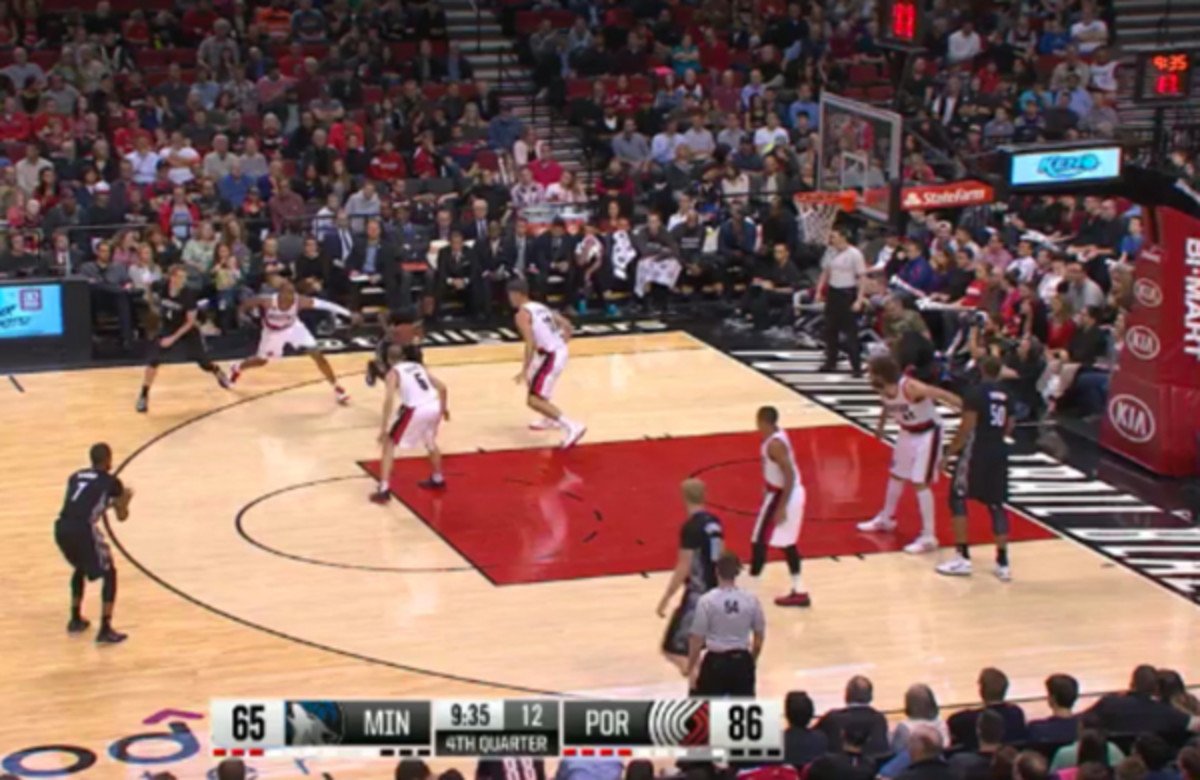
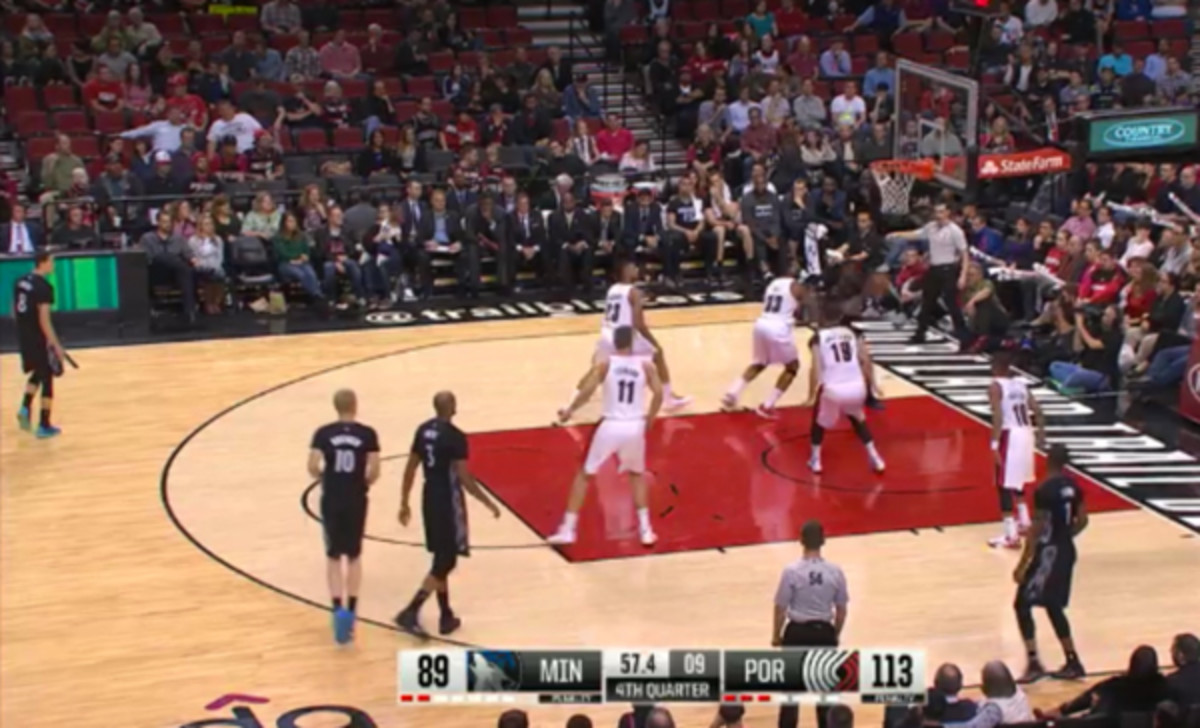
In sum, this amounts to a constant spacing crisis. This is life the hard away, visualized. The natural reaction is sympathy, as Wiggins is undertaking the basketball equivalent of repeatedly running into a brick wall. Remarkably, he's winning his share of the collisions. But so is the opposition. This accumulation of tough twos amounts to a series of real "Thank God" moments for smart defenses.
One-man valiance of this sort has a shelf life, with the expiration date eventually coming in the form of exasperation and/or wear on the body. Again: How can the Timberwolves, under Saunders, make Wiggins' life easier? And how quickly?
In latest comeback, Derrick Rose still searching for defined role on Bulls
Wiggins' rookie season will either go down as growing pains, like what Durant dealt with in Seattle, or as the beginning of a long frustration, like what eventually led Kevin Love to force his way out of Minnesota. In the case of Durant, Thunder GM Sam Presti did well to add complementary pieces, finding a second play-maker in Russell Westbrook and adding long defenders like Serge Ibaka to help narrow Durant's responsibilities and to make the most out of his talents. In the case of Love, then-Timberwolves GM David Kahn blew a succession of lottery picks, failing to construct a top-shelf offense and a competent defense around his All-Star power forward.
Asked where he wants to be at this time next year, Wiggins said, without hesitation: "In the playoffs." That's the correct mentality, even if it's an exceedingly unlikely goal given the Timberwolves' youth and the inertia that has built up over 11 straight lottery trips. To get this ship going the right direction, Saunders will need to think deeply about which of his existing pieces (Nikola Pekovic? Kevin Martin? Rubio?) make sense around Wiggins. He will also certainly need to reassess the importance of the three-pointer to the success of a Wiggins-led offense.
Saunders expressed on Wednesday a desire for Minnesota to improve as a three-point shooting team—remember, there's nowhere to go but up—and he said that he expects Wiggins' perimeter shooting numbers to naturally improve as he enters Year 2. The Timberwolves' future could very well hinge on Saunders taking these goals seriously and bucking his ingrained aversion to the three ball, or hiring a coach with a more modern appreciation for the outside shot.
To be clear, the answer isn't just for Wiggins to cross his fingers and jack threes. The long-term solution is to develop Wiggins into a consistent three-point shooter and, even more importantly, to build an offense that helps him fully bloom into a multi-dimensional threat, an offense that produces clearer driving lanes when he attacks, that generates good looks for him from outside to keep defenses guessing, and that surrounds him with competent shooters once he gets swarmed. None of those things are happening right now.
Wiggins is gifted enough to take home Rookie of the Year honors and develop into an All-Star by himself, without all that much help or strategic intervention. To win, though, he will need Saunders to thoughtfully construct an A+ attack around his A+ talent.
